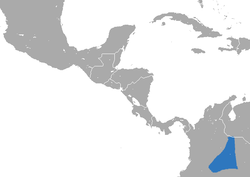| Brumback's night monkey [1] | |
|---|---|
 | |
| Scientific classification | |
| Kingdom: | Animalia |
| Phylum: | Chordata |
| Class: | Mammalia |
| Order: | Primates |
| Suborder: | Haplorhini |
| Infraorder: | Simiiformes |
| Family: | Aotidae |
| Genus: | Aotus |
| Species: | A. brumbacki |
| Binomial name | |
| Aotus brumbacki Hershkovitz, 1983 | |
 | |
| Brumback's night monkey range | |
Brumback's night monkey (Aotus brumbacki) is a species of night monkey found in Colombia. [1] It has traditionally been considered a subspecies of gray-bellied night monkey, Aotus lemurinus. [3] However, it has recently been argued that it should be considered a separate species. [4]
